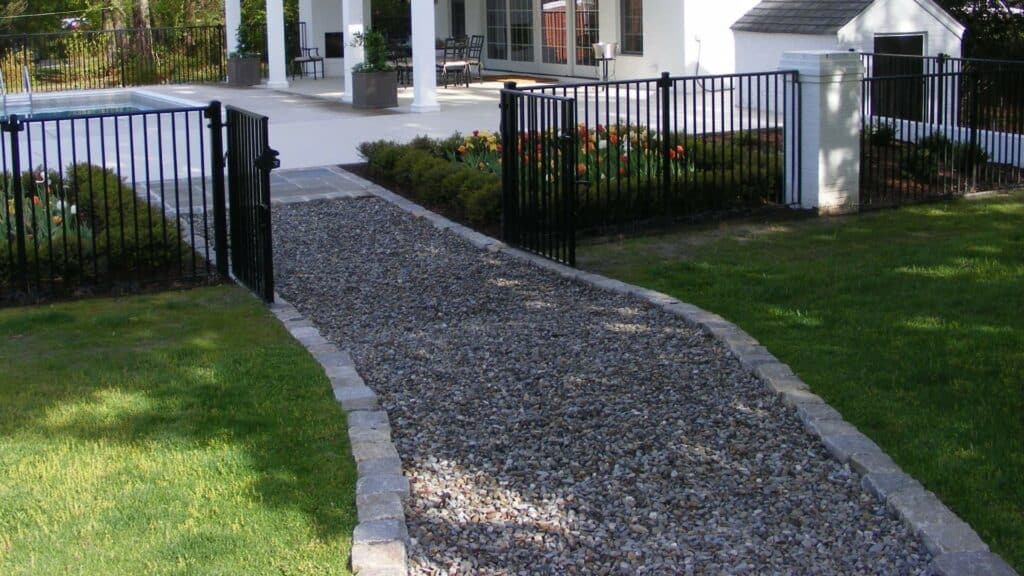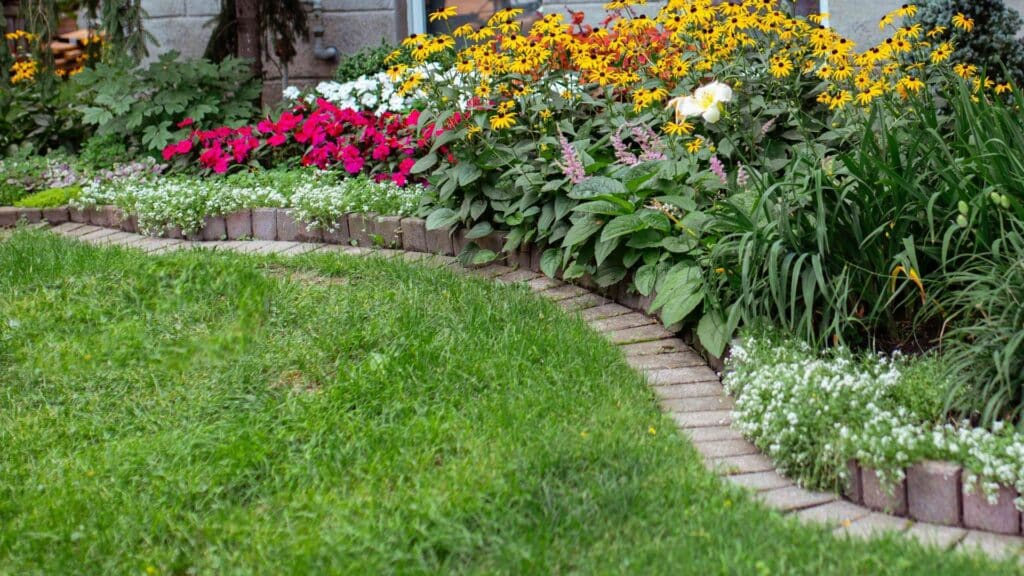When it comes to enhancing the beauty and functionality of your outdoor space, paver edging offers a versatile and attractive solution. Today, we want to talk about the best paver edging ideas going around.
Paver edging serves as a border, delineating and organizing different areas within your landscape while adding a touch of elegance.
With a plethora of design options, materials, and patterns available, you can customize your paver edging to suit your style and complement your existing landscape features.
So, let’s dive into the world of paver edging and discover inspiring ideas that will transform your outdoor environment.
Paver Edging Ideas: What Is Your Setting?
Paver edging is a versatile and practical element that can be used in various landscape scenarios to enhance the aesthetics, functionality, and durability of outdoor spaces.
So having an understanding of exactly what you want to achieve within the confines of the scenario you have is a pivotal point to plan a design that incorporates paver edging.
Here are some different ways in which paver edging can be used:
Pathway borders

Paver edging is commonly used to create defined borders for pathways. By installing paver edging along the sides of a pathway, you can prevent the pavers from shifting or spreading over time.
This not only enhances the appearance of the pathway but also provides a clear delineation between the pathway and surrounding landscaping.
Garden bed borders

Paver edging can be utilized to create borders around garden beds, flower beds, or raised planting areas.
This helps to separate the garden from the rest of the landscape while providing a neat and organized appearance.
This also helps prevent soil erosion and keeps mulch or gravel in place, ensuring a clean and well-maintained garden bed.
Retaining walls

In landscape and hardscape projects involving retaining walls, paver edging can be employed to give a finished and cohesive look to the structure.
The edging can be installed along the top edge of the retaining wall, providing a clean transition between the wall and the surrounding landscape.
This not only adds visual appeal but also helps to stabilize the soil and prevents erosion.
Patio and deck borders

Paver edging can be used to define the borders of a patio or deck. By placing the edging along the perimeter, you can create a clear separation between the paved or decked area and the rest of the yard.
This can help prevent the spreading of loose materials such as gravel or sand, keeping the patio or deck tidy and well-maintained.
Driveway or parking area borders

Paver edging is commonly employed in driveways or parking areas to create durable and attractive borders.
It helps to contain the pavers or other materials used for surfacing, preventing them from shifting or spreading.
Paver edging also adds structure and definition to the driveway or parking area, enhancing its overall appearance.
Pool edging

Paver edging is an excellent choice for creating borders around pools or water features.
It helps to separate the pool area from the surrounding landscape while providing a safe and aesthetically pleasing transition.
Paver edging can be used to create a raised border around the pool, providing a visual and physical separation from the rest of the yard.
Choosing the right material
Brick paver edging

Brick paver edging is a versatile and durable option that can enhance the aesthetic appeal of any outdoor area.
The use of brick pavers creates a clean and elegant border that defines the edges and adds a touch of sophistication to any design.
One of the main advantages of classic brick paver edging is its timeless appeal. Brick has been used for centuries and continues to be a popular choice due to its ability to seamlessly blend with various landscape styles.
Whether your outdoor space has a modern, traditional, or rustic theme, brick pavers can effortlessly complement the existing elements.
Brick pavers come in a variety of warm hues, ranging from rich reds to earthy browns. This extensive color palette allows you to select the shade that best suits your desired aesthetic.
Additionally, the natural textures of brick pavers add character and charm to your outdoor space, creating a visually appealing environment.
Brick is a robust material that can withstand heavy foot traffic, making it ideal for pathways, driveways, and flower beds. Its sturdy nature ensures that the edging remains intact even in challenging weather conditions.
As for the maintenance aspect, brick pavers are relatively low-maintenance. They are resistant to fading, staining, and deterioration over time, requiring minimal upkeep. This makes them a practical choice for homeowners who desire a beautiful and hassle-free outdoor space.
Design options
There are endless possibilities for experimenting with different laying patterns and design options.
One popular laying pattern is the running bond, where the bricks are laid in a staggered fashion, creating a visually dynamic and traditional look. This pattern works well for straight edges and can also be adapted for curved or meandering paths.
Another option is the stack bond pattern, where the bricks are stacked directly on top of each other, creating a clean and modern aesthetic. This pattern is often used for contemporary designs or for areas where a more minimalistic approach is desired.
For those looking to add a creative touch, you can create a mosaic effect by using bricks of different colors or sizes. By strategically arranging bricks in various patterns, you can achieve unique and eye-catching designs that add personality to your outdoor space.
Natural stone paver edging

Natural stone paver edging offers a timeless and captivating option for those seeking an organic and rustic appeal in their landscape design.
Using natural stone pavers, such as limestone, granite, or flagstone, adds a touch of natural elegance that seamlessly blends with the surrounding environment.
One of the big features that you can only achieve with natural stone paver edging is the irregular shapes and unique textures of the stones.
Unlike manufactured materials, each stone carries its own distinct character, resulting in a truly one-of-a-kind border. The irregular shapes create a sense of authenticity and add a charming, handcrafted feel to the landscape.
Not only that, but the unique textures of natural stone pavers also enhance their visual appeal.
The rough surfaces, subtle veining, and natural color variations of stones like limestone, granite, or flagstone provide depth and visual interest. These elements create a dynamic interplay of light and shadow, further accentuating the natural beauty of the pavers.
When selecting natural stone pavers for edging, it’s important to consider their compatibility with the overall landscape design.
By choosing stones that complement the existing hardscape materials or architectural elements, you can achieve a cohesive and harmonious look.
Design options
For a clean and contemporary appearance, laying the stone pavers in a straight line is a popular choice.
This creates a crisp and defined border that adds a sense of structure and order to the landscape. Straight lines work well for formal gardens or modern architectural styles, providing a sleek and polished look.
If you prefer a softer and more organic feel, arranging the stone pavers in a curvilinear pattern is a great option.
Curves mimic the natural flow of the landscape and create a sense of movement and fluidity. This approach is well-suited for gardens with organic or free-flowing designs, as it adds a touch of grace and a relaxed atmosphere.
To enhance the natural beauty of the stone paver edging, consider incorporating creeping plants or ground covers between the stones.
This not only adds a touch of greenery but also softens the overall look of the border. Plants such as creeping thyme, moss, or sedum can create a beautiful contrast against the stone pavers, bringing life and texture to the edging.
The combination of stones and vegetation creates a harmonious blend of natural elements, adding depth and visual interest to your outdoor space.
Concrete paver edging

Concrete pavers are the best option for paver material for a reason. They offer several benefits, making them a popular choice for various applications.
They are highly durable and can withstand heavy loads and harsh weather conditions. They are designed to resist cracking and crumbling, providing long-lasting performance.
Concrete pavers come in a wide range of shapes, sizes, colors, and patterns. This versatility allows for endless design possibilities, enabling you to create unique and visually appealing outdoor spaces.
Concrete pavers offer the best value for your money.
They are generally less expensive than natural stone pavers while providing similar aesthetic appeal and durability. Additionally, their modular design and ease of replacement can save costs in the long run.
Also, concrete pavers require minimal maintenance. They are resistant to staining, and regular cleaning with water and mild detergent is usually sufficient to keep them looking their best.
Additionally, the individual paver units make it easy to access and repair underground utilities if necessary.
Design options
Concrete paver edging offers a multitude of design possibilities, allowing you to experiment with various laying patterns and customization options to create a truly unique and personalized landscape.
The running bond pattern, where each paver is offset from the one below it, creates a sense of movement and adds a dynamic look to your edging.
The stack bond pattern, on the other hand, involves aligning pavers in a straight line, resulting in a clean and contemporary aesthetic.
These patterns can be used individually or in combination to create distinct sections or borders within your landscape.
For those seeking a more artistic approach, you can incorporate various colored pavers to create a mosaic effect.
By strategically placing pavers of different hues, you can achieve intricate designs, and patterns, or even replicate a specific image or logo. This allows you to infuse creativity and personality into your landscape design, making it truly one-of-a-kind.
In addition to different laying patterns, concrete pavers offer further customization options.
They can be stained or stamped to mimic the appearance of natural stone, allowing you to achieve the desired look without the expense or maintenance associated with natural materials.
Staining can be used to add depth and variation to the pavers, while stamping can create textures and patterns that resemble natural stone surfaces like slate, flagstone, or cobblestone.
This versatility opens up a world of design possibilities, allowing you to seamlessly integrate the concrete paver edging with other elements in your landscape.

Ask for professional help
As you could see, there are many options for materials – and even more options for designs – when it comes to choosing a paver edging for your project.
The safest way to navigate all those choices is to work with professionals in the field, both in the design and in the hardscape business. So look for professionals in your area that can help you with your project.
In case you are around the Sarasota and Manatee counties, in FL, we here at S&S Pavers would be glad to help you.
You can contact us anytime for a consultation on our services.




